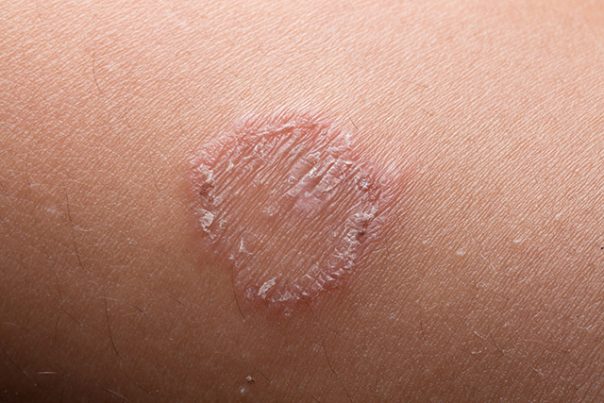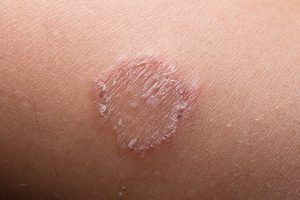
Tinea barbae – causes, side effects and treatments at NaturalPedia.com
Wednesday, July 11, 2018 by Janine Acero
http://www.naturalpedia.com/tinea-barbae-causes-side-effects-and-treatments-at-naturalpedia-com.html

Tinea barbae, commonly known as ringworm, is a skin condition that’s not at all caused by a parasitic worm. It is a fungal infection that usually occurs at the beard area of the face and neck, but may also affect different parts of the body. It causes swelling and crusting, often with itching. It tends to grow outward on skin, producing a ring-like pattern – hence the name “ringworm.”
Tinea barbae was called “barber’s itch” in the days when men went to the barber daily for a shave.
The infection can be transmitted via human contact, contact with the soil or with animals.

Known symptoms and risk factors for tinea barbae
The lesions caused by tinea barbae may or may not be inflammatory. The inflammatory lesions are red with swelling of the skin and nodules. There may be discharge from the lesions as well. The affected individual may also experience pain in the affected area. The non-inflammatory lesions may be red and swollen but no pain or discharge.
Ringworm infection can also cause hair loss, called tinea capitis (mainly a disease of children).
Severe cases of this condition may result in severe itching and a visible red rash at the affected area. The rash is mostly visible in the chin and neck which may then spread from there.
The likelihood of contracting this infection is increased by the following factors:
- Secondary infection, such as cellulitis and impetigo.
- Playing contact sports.
- Weakened immune system.
Body systems harmed by tinea barbae
Untreated tinea barbae can result in secondary bacterial infection. Tinea capitis (hair loss) is another complication, but it usually occurs in children. Pain and difficulty with shoes can result from tinea unguium, a fungal infection of the nails.
Food items or nutrients that may prevent tinea barbae
Certain nutrients help repair damaged skin caused by infections, including tinea barbae.
- Vitamin A-rich foods – Vitamin A helps repair skin tissues, which may help reduce scarring as the skin heals. Vitamin A is found in beef and fish liver, eggs and dairy products. Your body can also produce vitamin A from carotenoids, particularly beta-carotene, which is found in carrots, apricots, hot peppers, kale, mustard greens, parsley, and spinach.
- Vitamin E-rich foods – Vitamin E also helps in the production of skin tissue, potentially reducing scarring. Good sources of vitamin E include olive oil, sunflower oil, eggs, hazelnuts, lentils, almonds, sesame seeds and whole-grain breads.
Treatments, management options for tinea barbae
Treatment for ringworm infection mainly involves removing any hair in the affected area, and applying antifungal creams and lotions. Topical medications are often enough to treat mild cases of ringworm. For some extreme cases, oral antifungal medications are recommended by the treating physician. Some of the medications used for treatment of ringworm infection include Fluconazole, Itraconazole, and Terbinafine.
The following is a list of basic lifestyle habits that may help prevent and/or manage ringworm infection.
- Good skin hygiene.
- Good nail hygiene.
- Avoid prolonged wetting or dampness of the skin and feet.
- Avoid wearing trainers or running shoes which can retain sweat and promote a warm, moist environment for fungi to thrive in.
- Wear clean, loose-fitting underwear.
Families should also be extra careful about what you share with family members:
- Teach kids not to share hats/caps.
- Make sure each family member uses their own comb/brush.
- Do not share razors.
Athletes and regular gym-goers should be sure to wipe down or avoid sharing athletic equipment.
Where to learn more
- Tinea Versicolor Natural Treatment
- Use Natural Cures for Tinea, or Fungal Skin Infections
- Home Remedies for Razor Bumps (Pseudofolliculitis Barbae)
- Essential Tips: 5 Home Remedies for Athlete’s Foot
- 15 Natural Home Remedies for Ringworm
Summary
Tinea barbae, or ringworm, is a fungal skin infection that usually occurs at the beard area of the face and neck, but may also spread to different parts of the body.
Tinea barbae causes swelling and crusting of the skin, often with pain and/or itching. It tends to grow outward on skin, producing a ring-like pattern – hence the name “ringworm.”
Tinea barbae can be treated with topical medications for mild cases, and oral antifungal medications for severe cases.
Sources include:
Tagged Under: Tags: Ringworm, Tinea barbae





